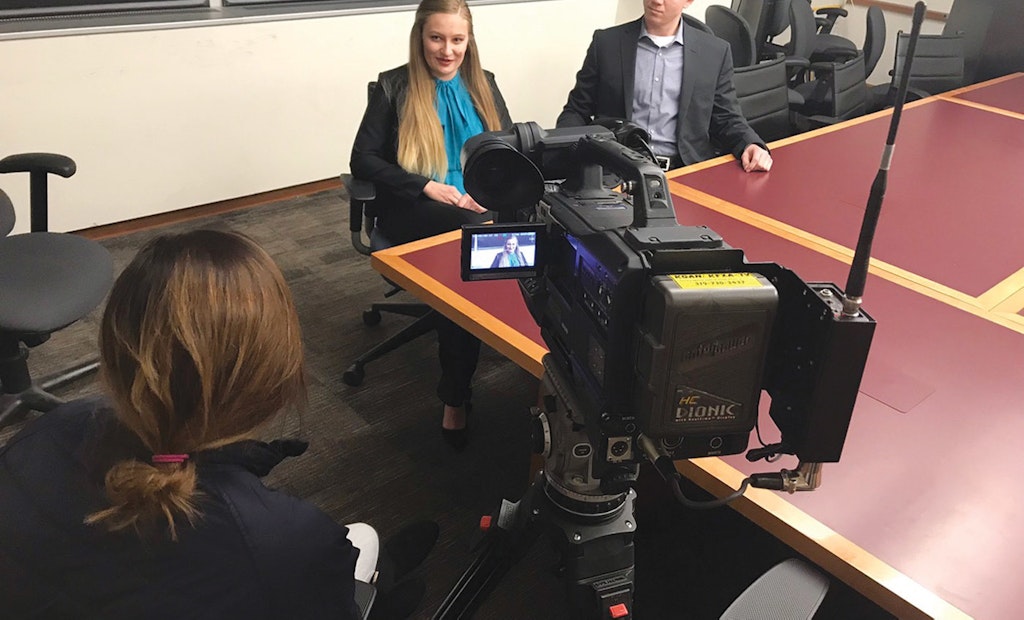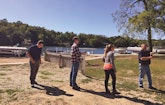
Kelly Wolner, left, and Jason Ruffatti, right, of the University of Iowa are interviewed about their role in wastewater system repairs at Lake Delhi. The story of how engineering students helped analyze options for lake property owners received wide coverage.
When the dam failed at Lake Delhi in northeastern Iowa in 2010, the state agreed to help Delaware County and local property owners pay for a new one, but the state placed a condition on its aid: All onsite systems at the longtime lake community had to be working properly. With about 880 homes around the lake, it was a tall order. But it also became an opportunity for university students to help fix a real-world problem in a county with limited resources.
The dam failed following heavy rains. In less than 24 hours, the watershed received about 12 inches of rain, says Dennis Lyons, sanitarian for Delaware County where the lake is located. Lake Delhi is an impoundment on the Maquoketa River, and when the dam failed, it was as if someone pulled the plug in a bathtub, Lyons says.
Before the dam breach, there had already been meetings about improving onsite treatment and water quality in the lake. In 2005 the Eastern Iowa Regional Utility Service System (which helps counties and communities plan, finance, build, and operate essential services) met with a consultant about preparing a wastewater plan. The consultant proposed three centralized systems with an estimated cost of $15 million.
“With the lay of the lake and everything, it was clear that $15 million was not going to cover it, and at the time, funding was not available from the state,” Lyons says.
SEEKING A SOLUTION
The only solution was improved decentralized treatment, and in 2017 that led Delaware County into a partnership with the University of Iowa to help formulate cost-effective answers for Lake Delhi property owners.
The project came to the university’s Iowa Initiative for Sustainable Communities. It has existed for nine years, and its mission is to link university resources with communities to help solve problems, says Travis Kraus, assistant director of the initiative.
“We like to hear about the challenges and what issues people are trying to solve, and then we think about what department can satisfy the need best. We put together the pieces and find the right people to help,” Kraus says.
Sometimes the initiative partners with a city or town, but for the last couple of years, partnerships have been with regional organizations. That allows small communities like Lake Delhi to take advantage of university expertise, he says, because such communities usually don’t have large enough budgets or staffs to support joint projects with the university. Cost is definitely an advantage for organizations that partner with the university.
“When we do something, it’s at a much lower cost than a consultant. We don’t think of ourselves as replacing consultants, but enhancing their ability because in many cases they use the student work as a starting point, which saves money. We feel many projects we’re involved in wouldn’t be done otherwise,” Kraus says.
In this case, the project was referred to an environmental engineering class.
SEWER VS. SEPTIC
For senior Jason Ruffatti, it was a very attractive project because it was so different.
“I’ve done a few internships, but I’ve never really done a project this involved,” he says.
He had never been on a site visit nor had to contact a large number of people to gather information. Most student projects are set up so they are easily understood and solved, he says. “This one turned out to be more real than the others.”
The environmental engineering class he was in focuses on municipal systems. Before the Lake Delhi project came along, Ruffatti had no acquaintance with onsite technology.
“The biggest design issue we had was dealing with the harsh topography at Lake Delhi. And with some of these homes, there’s not a lot of space between them,” Ruffatti says.
Terrain around the lake is hilly with steep slopes down to the water. The small lots made it almost impossible to fit onsite systems onto some properties and remain within the property boundaries, he says.
“In my opinion, putting in sewer systems would have been much easier than finding an individual spot for each system at each home. Of course, putting in a conventional system would have required dealing with the same topography,” he says. “Onsite technology is very promising, I think, and it’s cool what these little systems are able to achieve as far as removal.”
What surprised him was how clean onsite effluent can be. When the students finished their calculations, they found some systems could discharge treated wastewater directly into the lake, no drainfield required.
The second biggest issue was not having much information on the existing systems. It was surprising that some homes are outfitted with AdvanTex systems (Orenco Systems), while others have systems installed in the 1960s and owners have no idea about how it functions, he says.
“I think students should absolutely do more of this kind of work because most real-world problems are extremely nuanced like this one,” Ruffatti says.
THREE SYSTEM OPTIONS
Student assistance was also valuable for the county.
“The way I looked at it, I just like to have an extra set of eyes looking. I can’t say they came up with anything I didn’t look at before,” Lyons says.
But the students could devote a larger block of time to the project than county staff, he says. They had time for a thorough analysis of the problem and time to prepare a good presentation about the solutions. Their report was 28 pages of history, satellite photos with color-coded boxes showing treatment sites, decision tables that scored alternatives on a variety of factors, and costs.
The options break down to three: an AdvanTex system, a Premier Tech Aqua Ecoflo system with a coco filter, or a holding tank. The tank is the last option on everyone’s list, yet in one case the students overruled their own decision table and recommended a tank. The location was very near a well, Ruffatti says, and the students wanted to avoid any possibility of contamination.
A new Lake Delhi dam was dedicated in 2016. The students filed their final report in December 2017. What happens next is up to the landowners.
“I send a letter out every year to the people who do not have their systems checked out,” Lyons says.
This year he is planning a meeting for early summer so residents can see some of the options available to them. About 156 homes still need upgrades, and there is a clock ticking. Originally the state allowed 10 years for onsite system upgrades around the lake. Five years remain.







